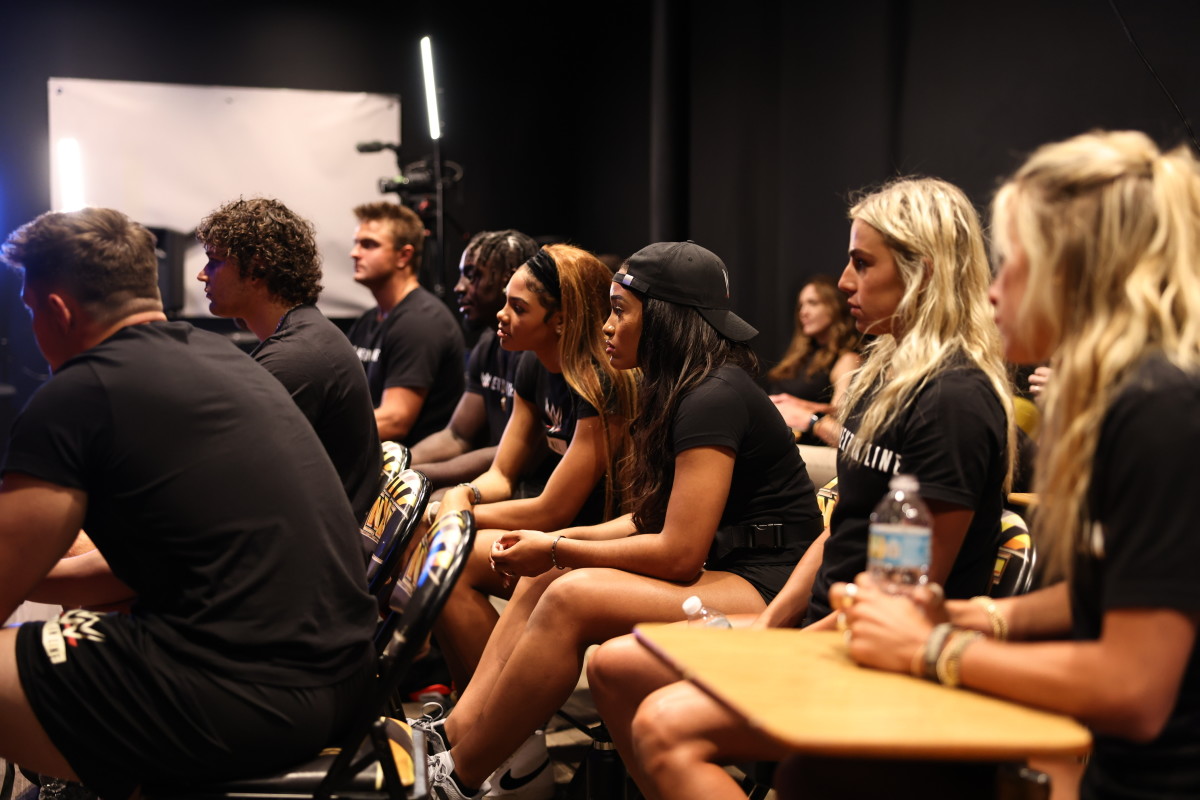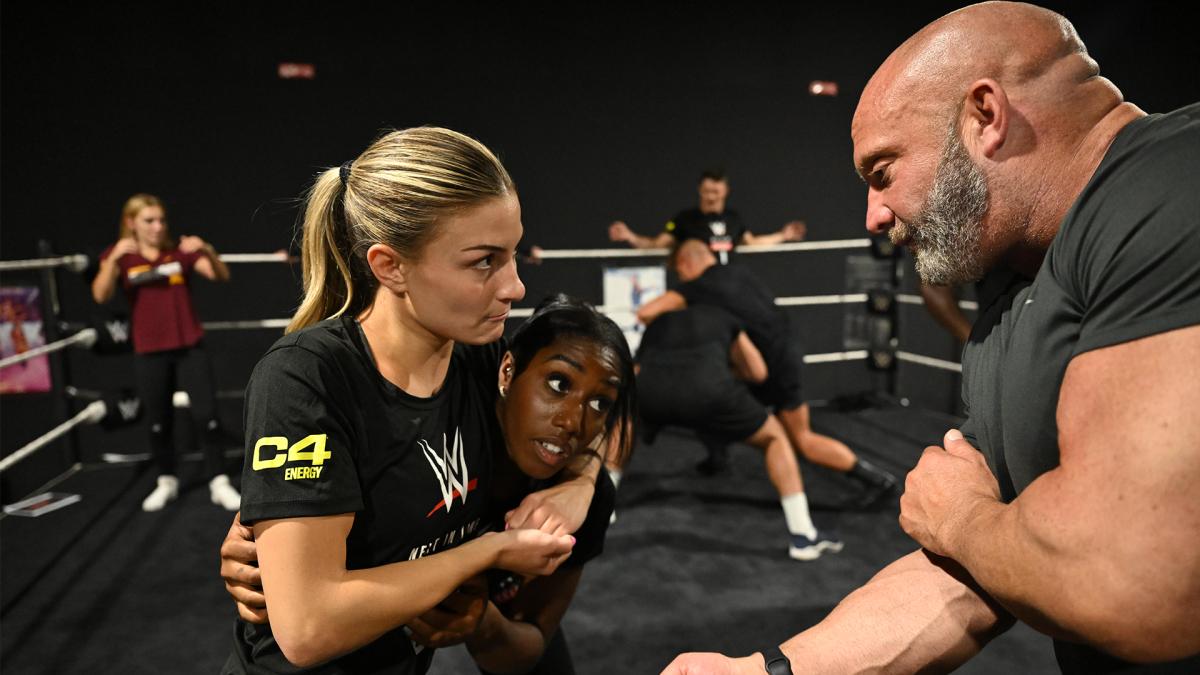WWE Created Its Own NIL Pipeline for Recruiting College Athletes. Now It’s Paying Off.
This story is part of Sports Illustrated’s exploration of the ways sports and finance intertwine—from the NIL revolution to online betting, business-minded athletes and more. For more on sports and money, see SI’s October 2023 Money Issue.
As a Northwestern defensive lineman from 2017 to ’21, Joe Spivak always dreamed of making it to the pros one day. But he also envisioned another postcollege path, one that combined the chaos, violence and competition of the gridiron with his “love of being in front of people.”
“WWE was not only in the back of my mind, but definitely in the front of my mind, too, even while still chasing that NFL dream,” Spivak says. “Especially after being in the NIL program.”
During the fifth year of eligibility he was granted at Northwestern due to COVID-19, Spivak contacted the organizers of Next in Line, the WWE’s new NIL program. Fast forward to October 2022, and Spivak officially traded in his cleats for spandex, the football field for the ring and his birth name for a moniker more suited to his boisterous, infectiously enthusiastic antics: Tank Ledger.
Spivak and Tokyo Olympics gold medalist wrestler Gable Steveson were the first members of WWE’s Next in Line class to appear in the ring—one WWE official involved in the organization's development and recruitment efforts called Spivak WWE’s program a “high-level case study” in the NIL space. “That’s how we drew it up,” he says, “and we hope to continue down that path.”
WWE views NIL as “a great opportunity” to target potential superstars early in their careers; the goal is to “open up a new, direct entry point” into their system. But Spivak is far from the first collegiate athlete to make the transition to WWE. John Cena, “Stone Cold” Steve Austin and Dwayne “The Rock” Johnson all played collegiate football, and reigning women’s champion Bianca Belair ran track at three schools. More recently, Baylor tumbler Alexis Amrhein has hopped into the ring under the name Dani Palmer.
Belair, who got her WWE start in 2016 at the age of 27, has been vocal about her support of the NIL program. She says it “took her a minute” to figure out what she wanted to do after her dreams of being an Olympic track athlete didn’t pan out; an official framework could have changed all that.
“I can only imagine if I had an NIL program,” she says. “I would have had a clear path into WWE … and jump-started my career a whole lot sooner.”
Belair is serving as a mentor to the young athletes currently involved in the NIL program, answering questions, offering advice and helping with the potential transition of wrestling full time. “Maybe I’ll be meeting them in the ring at WrestleMania,” she adds.

So who’s next to take the plunge? The WWE normally receives “hundreds if not thousands” of applications for those tryout spots, but NIL signees get to “jump the line.” In July, athletes involved with the Next in Line program gathered at the WWE Performance Center in Orlando, in what officials call the “next phase” of the program. No one got in the ring, as the purpose of the visit was more to give athletes “a look at what it is to be a WWE superstar.”
Among the attendees were Arizona State fullback Case Hatch, South Carolina high jumper Rachel Glenn and Miami women’s basketball guards Haley and Hanna Cavinder. Later, in August, seven athletes took part in WWE’s first NIL tryout: Hatch, Illinois wrestler Luke Ford, Central Michigan women’s basketball player Mikala Hall, Auburn gymnast Derrian Gobourne, Life University wrestler Peyton Prussin, Pitt thrower Otoniel Badjana and Stanford edge rusher Thunder Keck. Two more athletes, Hofstra wrestler Zachary Knighton-Ward and Arizona State thrower Turner Washington, attended a later tryout.
Finding athletes who might be underrated, underutilized or undervalued is part of the WWE’s methodology because, at the end of the day, the goal is to create more WWE talent.
“If we went after just those with big followings, or those that were NFL bound, it wouldn’t leave us in a good place,” one talent official says. Instead, they’re looking for “those athletes that may not have those high-level opportunities at the end of their collegiate careers,” but have “high-level potential” to have lengthy stints in the ring.
#WWENIL athletes step in front of the camera and into the ring at the WWE Performance Center! Powered by @c4energy pic.twitter.com/3FqqRa8M5S
— WWE Recruit (@WWERecruit) July 11, 2023
With a final combined NIL valuation of $1.85 million—not to mention a combined 1.4 million Instagram followers—the Cavinder twins are far and away the biggest names signed to Next in Line, followed by Keck, with a $529,000 valuation, according to On3. Valuation information was available for only nine of WWE’s 45 signees, and, with the Cavinders included, earning projections averaged out to $337,555. In terms of compensation compared to leagues like the NFL, WWE says it’s “staying ahead of the curve” and being competitive with its contracts.
In 2022, retired superstar Paul “Triple H” Levesque—who now acts as WWE’s chief content officer and head of creative—told The Athletic wrestlers on the main Raw and Smackdown rosters earn “at least $250,000 annually.” A ’19 report from Sports Business Journal said developmental contracts for NXT talent range between $50,000 and $150,000 a year; that aligns with comments made by Wrestling Observer’s Dave Meltzer, who said in a podcast that NXT talent makes “in the low $100,000s.”
Big names on WWE’s main roster stand to make much more than Levesque’s $250,000 minimum. In 2021, Forbes reported that former NCAA wrestling and UFC heavyweight champion Brock Lesnar was raking in $10 million, while Roman Reigns made $5 million. The highest-paid woman that year—Becky Lynch—made $3 million.
Hanna Cavinder says, for female athletes like herself, the WWE can provide new opportunities for athletes to thrive in a competitive, entertaining environment—especially for those who aren’t necessarily passionate about pursuing a career in their collegiate sports.
“With basketball, there’s not a lot of opportunities professionally in the WNBA, or you can play overseas,” she says. “If that’s not something you want to do, but you’re still competitive and want to be in the sports and entertainment world, then what’s better suited for you than WWE?”
But it’s not all about athleticism and physicality. What sets NIL targets apart is their charisma and overall personality—ideally, the qualities that can morph them into compelling wrestlers and entertainers. “If we were looking to just sign athletes, we could do that pretty much all day long,” the WWE recruiter says.
That’s why, at the WWE Performance Center in June, nine athletes spent their time cutting promos, doing media training and getting a feel for superstar life. Part of that, naturally, is figuring out who they’ll be should they ever set foot in the ring.

Hatch, whose collegiate football claim to fame was breaking multiple facemasks, was first approached by WWE following his junior year. (His broken facemask count that season? ”Three or four.”) That level of intensity could prime him for a WWE heel role, one that he says conflicts with his real-life demeanor.
And he’s totally O.K. with that.
“If I am able to portray myself in a way where I get in the ring and I’m a completely different person … that would be ideal,” Hatch says. “Whatever you need, I’ll help you out with, but when you get in the ring with me, don’t talk to me. It’s time to fight.”
Glenn says the combination of her athleticism and high school theater background makes professional wrestling something that’s “up her alley.” But unlike Hatch, she sees herself being a face—largely because she, admittedly, “sucks at smack talk.”
And for the Cavinders, they already invite a one-to-one comparison to the Bella Twins, who both won WWE’s now defunct Divas Championship. (When asked, Haley says emphatically that, if wrestling is in her and her sister’s future, they’d work as a tag team: “No fighting against each other.”)
Whatever path NIL athletes take, they can know that—should they hop in the ring—WWE superstars like Belair will be waiting. Mentors turned competition.
“I’ve made a lot of history in WWE and set a lot of records, and records are meant to be broken,” Belair says. “I tell every single one of them: ‘Come after me. Come break those records and meet me in the ring.’”
